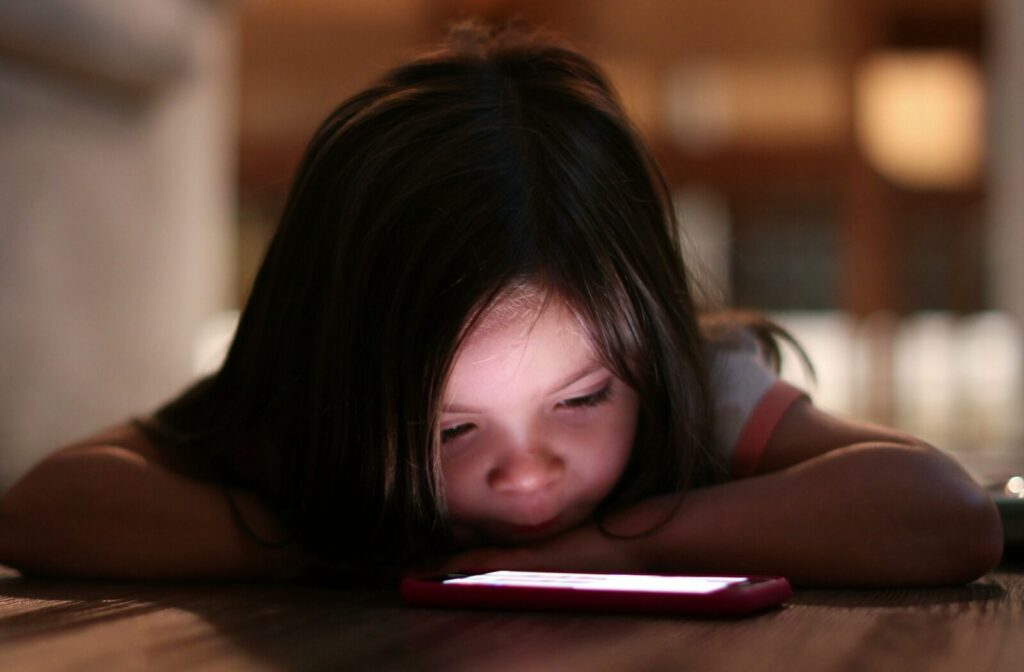Nearsightedness often begins in childhood and can gradually worsen over time, leaving many parents and adults wondering what drives the changes that it causes. While glasses or contacts may correct vision, they don’t stop myopia from progressing.
In fact, myopia tends to worsen over time due to a combination of genetics, age, screen time, and a lack of outdoor activity. Recognizing these risk factors early can help you take meaningful steps to protect your vision and slow further progression.
Exploring Myopia Progression
Myopia occurs when the eye grows too long from front to back or when the cornea is overly curved. This prevents light from focusing directly on the retina (a structure at the back of the eye that converts light into signals for the brain), resulting in blurry vision for distant objects. Several factors influence how quickly or severely myopia can progress.
How Genetics Impact Myopia
Myopia can run in families, meaning that genetics often play a role in its development. If both parents are nearsighted, their child has a higher risk of developing myopia. However, genetics aren’t the sole factor. Environmental and lifestyle habits equally impact the onset and progression of this condition.
While we can’t change our genetic predisposition, understanding the risks involved promotes early monitoring and proactive care, especially for children. Regular eye exams are helpful for monitoring changes in vision and addressing potential issues early.
The Role of Age in Progression
Age is a predominant factor in myopia development. Typically, myopia begins during childhood, while the eyes are still growing. It often continues to worsen through the teenage years before stabilizing in adulthood. This progression is largely due to elongation of the eyeball as a child grows.
Monitoring children’s vision is particularly important because early intervention can slow the progression of myopia.
Environmental Influences on Vision
Environmental factors are increasingly recognized as contributors to myopia progression. Modern lifestyles, heavily reliant on digital screens and indoor activities, have increased the risk of developing vision issues. Here are some common contributing factors:
Prolonged Screen Time
Extended use of smartphones, tablets, and computers has been linked to higher rates of myopia, especially among children and young adults.
Lack of Outdoor Activity
Studies indicate that children who spend more time outdoors tend to have a lower risk of developing myopia.
Close-Up Work
Activities that require extended focus on objects up close, such as reading or crafting, can contribute to myopia. Without regular breaks, the strain on the eyes may lead to vision deterioration.
How to Manage & Prevent Myopia Progression for Your Child
While genetic predispositions and age can’t be controlled, there are several proactive steps you can take to help prevent or slow your child’s progression of myopia. Here are some tips:
- Limit your child’s screen time: Adopt the 20-20-20 rule. After every 20 minutes of screen time, have your child look at something 20 feet away for at least 20 seconds.
- Encourage outdoor activities: Aim to provide your child with at least one to two hours of outdoor play or activities daily when possible. Natural light has been shown to reduce the risk of myopia progression, making fresh air and sunshine invaluable for their eye health.
- Optimize their workspace: Use proper lighting for reading or studying to help reduce unnecessary strain on your child’s eyes. Position them near a window for natural light.
- Have your child take regular breaks: Whether they’re studying, reading, or enjoying a hobby, remind them to rest their eyes periodically to prevent overexertion.
- Increase their physical activity: Regular exercise not only supports overall health but can also benefit your child’s vision. Encourage a balanced lifestyle that includes movement and reduces sedentary behavior.
- Schedule regular eye exams: Eye exams are helpful for early detection and intervention. They allow optometrists to monitor your child’s vision changes and recommend myopia control methods.

Myopia Control Options
If you’re concerned about myopia progression, we offer several myopia control options.
Specialized Glasses or Contacts
Glasses designed for myopia control and multifocal contact lenses can reduce strain on the eyes while slowing progression.
Orthokeratology (Ortho-K)
These specialized contact lenses gently reshape the cornea overnight, allowing clear vision during the day while actively managing myopia.
Atropine Drops
Prescription atropine eye drops can help slow myopia progression, particularly in children.
MiSight®
MiSight lenses are soft, daily disposable contact lenses made specifically for children with myopia. FDA-approved, they not only correct blurry distance vision but also help slow down the progression of myopia over time.
Take Charge of Your Vision Health
With the right steps and support, the progression of myopia can be managed effectively. By adopting healthy habits, reducing screen time, and working closely with an eye care professional, you can protect your child’s vision for years to come.
At Fuquay Eye Care, we specialize in individualized myopia management plans to help you and your family see clearly and live comfortably. Reach out today to schedule an appointment or consult with our team about your concerns.





